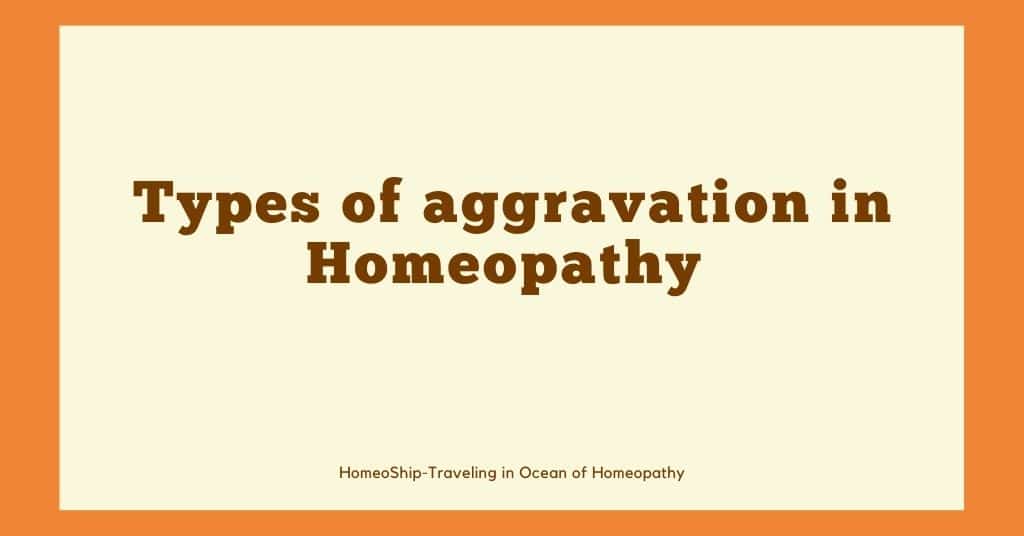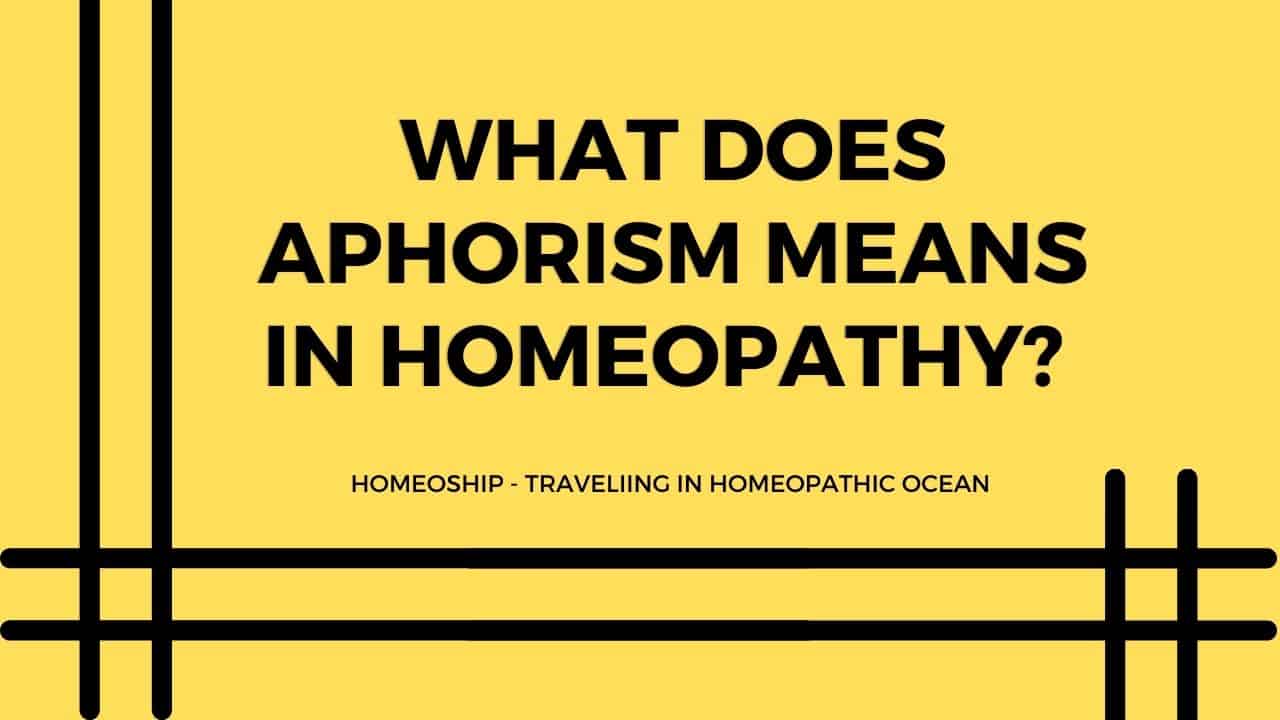Aggravation means the state of becoming worse or more serious; exacerbation. But for us (Homeopath) it means a lot different, in our day-to-day practice, we come across different types of aggravations. After administering the remedy, the patient may complain that his symptoms are growing in intensity. Proper understanding and clinical interpretation of the condition will help in managing the case. Some aggravations have good prognostic value and some have bad prognoses. Hence, knowledge of different types of aggravation is mandatory for homoeopath for judicious employment of medicines.
Types of Aggravation
- Homeopathic aggravation
- Medicinal aggravation
- Disease aggravation
- Killer aggravation
1. Homeopathic Aggravation
The homeopathic remedy is always administered in “a similar yet stronger” manner than the natural disease. The medicine removes the weaker miasmatic disease as a result of its primary action. Now, the place of miasmatic disease has been occupied by the stronger medicinal disease. Because of the strongness of the dose, the patient may experience a sense of an increase in his original symptoms.
These increased symptoms have a resemblance to the original miasmatic disease. Hence, the patient may think that his disease itself is increasing. But the intelligent physician can observe that it is the “homeopathic aggravation” and not the “disease aggravation”.The increased symptoms are because of the strongness of the dose.
Definition: Homeopathic aggravation is a slight intensification of the existing symptoms of the patient with the inner well-being of the patient. This happens when the remedy has been administered in a slightly stronger dose.
The homeopathic aggravation is because of the primary action of the drug on the vital force. The similar, yet stronger medicine unconditionally attacks the diseased parts. The diseased parts are already susceptible to similar disease symptoms. So they easily adopt the medicinal disease also. The medicinal disease has so many other symptoms than the original disease but because of the minuteness of the dose, they will not come into play and remain quiescent.
Nature’s law says, “The stronger medicinal disease can easily remove the weaker miasmatic disease”
Hence, now the vital force is only suffering from the stronger medicinal disease. Because the medicinal disease is stronger, the patient feels that his disease has increased after the intake of the medicine. This is the “homeopathic aggravation” and not the “disease aggravation”. Such an increase in the intensity of the existing symptoms of the patient is called “homeopathic aggravation”
Homeopathic aggravation in acute diseases: The “homeopathic aggravation” in acute diseases is seen in the first few hours of the administration of the remedy. It has a good prognostic value. The smaller the dose of the medicine, the slighter and shorter will be the aggravation. As a result, the patient recovers very soon.
Homeopathic aggravation in chronic diseases: The aggravation in case of chronic disease can not be seen immediately after the administration of remedy but after the remedy is repeated for a long time in proper small, gradually increasing higher doses with renewed dynamization, it can be observed. It usually occurs at the end of the treatment when the cure is almost finished.
Prognosis and interpretation of the physician:
1. The slight homeopathic aggravation is a good indication. It shows that the remedy administered is not only similar but also stronger. The patient is on the road to recovery.
2. The intensity and the duration of aggravation depend upon the dose of the medicine administered. But, the dose of homeopathic medicine can never be made so small as to avoid even the slightest homeopathic aggravation and bring about the cure. So, the selection of the dose is purely done by the experience of the physician. After the aggravation, amelioration follows uninterruptedly.
3. The medicinal disease loses its power over a while because of its minuteness of the dose and dynamization. The medicinal disease now becomes weaker and weaker. As a result of the secondary action of vital force, now the weaker medicinal disease is also removed.
4. According to Hahnemann, the homeopathic aggravation indicates:
- The cure is approaching.
- The vital force is now free of the natural disease and is only suffering from the medicinal disease.
5. The homeopathic aggravation should not be interrupted. It should be allowed to run its course. Further, repetition of any medicine including the selected remedy has to be stopped. For the satisfaction of the patient “placebo” can be given.
In the footnote to § 160, Hahnemann explains the experiences of non-homoeopathic physicians with homeopathic aggravations. This happened when they employed the medicines in a homeopathic manner without their notice.
Dr Leroy experienced homeopathic aggravation when he administered “Viola tricolour” in a case of a facial eruption. Dr. Lyson experienced this in a case of skin eruption when he administered “bark of elm”. Both these physicians have reported the occurrence of aggravation before cure. But they could not find the fact that this aggravation had taken place because these drugs were truly homeopathic to those conditions.

Medicinal Aggravation
Definition: Medicinal aggravation can be defined as the appearance of “new medicinal symptoms” in a patient after the administration of a wrongly chosen medicine.
Accessory symptoms of the medicine
Whenever the homeopathic medicine has been chosen wrongly or repeated unnecessarily, such a condition may arise. The patient complains for a certain time about the appearance of new symptoms. Further, he complains that he had never experienced such symptoms in his lifetime. The new symptoms produced by the wrongly chosen medicine are called as “accessory symptoms of the medicine.” Those new symptoms can be easily identified by referring to the materia medica.
Prognosis and interpretation of the physician:
1. The medicinal aggravation has a bad prognosis. It shows that the administered remedy is not the similimum one and the patient is proving the medicine.
2. If the symptoms are serious, the medicine has to be antidoted immediately.
3. If the medicinal symptoms are of mild to moderate intensity further repetition of the medicine has to be stopped immediately. The physician has to wait till the new medicinal symptoms pass away and later, the new similimum can be searched for the original disease symptoms.
4. If the medicinal symptoms and the original diseased symptoms are mixed up, a suitable medicine that covers both, can be selected and administered.
Disease Aggravation
Definition: Disease aggravation can be defined as the appearance of the bad prognostic, advanced symptoms of the nosological disease condition. This indicates that the chosen remedy is wrong and it does not show any impact on the disease condition. The disease is advancing in its course.
Prognosis and interpretation of the physician:
If the chosen medicine is not homeopathic, does not suit the case properly, and is not repeated too frequently, this does not have any impact on the disease. In such a case, the disease will progress in its course, despite the application of the medicine. Hence, the patient complains of aggravation of his complaints. New symptoms with great intensity will also be found. The patient’s condition on examination, seems to worsen physically, mentally, and intellectually. In such conditions, correct interpretation can only save the patient. It has to be differentiated from the medicinal aggravation. This can be done easily by referring to the materia medica.
When new symptoms are not of the prescribed medicine, then referring to the knowledge of surgery, gynaecology, and medicine will help us to find out the complications and bad prognosis of the disease. The timely use of diagnostic procedures like E.C.G., X-rays, and M.R.I., etc will help us in realizing that previously prescribed medicine is not working and the disease is advancing into its complicated stage. It is neither the “homeopathic aggravation” nor the “medicinal aggravation”. In cases where the disease aggravation is identified, the case has to be retaken and proper remedy in the proper dose and proper repetition has to be done.

Killer’s Aggravation
Definition: Killer’s aggravation can be defined as the condition arising from the untimely prescription of the constitutional curative remedy in pathologically advanced cases of incurable cases.
Prognosis and interpretation of the physician
1. Killer aggravation has an almost fatal prognosis.
2. This kind of aggravation results purely because of the physician’s improper handling of the case. In pathologically advanced, difficult, and incurable cases, the pioneers have advocated the palliative method because in such cases vital force has lost its reactive power. Hence such cases cannot be cured by homeopathy. Dr. H. A. Roberts has an opinion, “the aggravation of the diseased state may come from an incurable state’, which is stirred to it’s foundation by the potentised remedy, and unless the remedy is counteracted the disease will become worse and rapidly approach a fatal termination.”
3. Without having this idea, if any homeopath selects a well-chosen, deep-acting, constitutional remedy to a patient whose condition is very much worse, the result will be disastrous. The deep-acting remedy does its work by producing primary action. But the debilitated incapable vital force cannot produce the secondary curative action. The result will be dangerous in such conditions. If the prescribed potency is high, and repeated too frequently, owing to the similarity to the case, the patient cannot withstand the aggravation and it can even kill the patient if the disease is affecting the vital organs.
4. Hence, in such cases the physician must understand that the vitality is almost lost in the patient. Here he must think of only the palliative remedies to remove the most annoying symptoms of the patient and should not aim at cure.



I like what you guys tend to be up too. This kind of clever work and reporting!
Keep up the awesome works guys I’ve added
you guys to my own blogroll.
The remedy chosen was Carsinocinum 1M. It was used based on a doctor who used it successfully for cancer. I am attempting to treat growth in the throat with secondary impact on nasal quality. I am a novice. I would like to know how to reverse the cure if ive produced a medicinal or killer aggravation! I only gave 2 doses.
Never haphazardly select the medicine. Kindly try to learn about the anti-dote of medicine, it will help you.
And in my own case, as a novice, i took Arsenicum Album 30c every 15 minutes for 6 total doses, for shortness of breath, wheezing due to emphysema and copd. Well, Im having some aggravation, but i dont know what kind, (disease, medical or killer) along with improvement of symptoms. Im experiencing mild shortness of breath every few hours, and then i had extremely strong urge for repeated but negligible bowel movements, with gastric cramping. That condition stopped. I was in very impacted situation in my breathing. I had to do something, however, im apprehensive because i did not realize the severity of making a mistake with homeopathic medicine!
Never try homeopathic medicine randomly. If you have any symptoms which are not bearable by you, then contact any expert homeopathic physician near you. Also, Read This http://homeoship.com/repetition-of-doses/
very good expression. Need more example different aggravation with action time and antidoted.
Surely, We will post a completely new post on examples of aggravation with real cases. Stay Tunned and bookmark our Website.